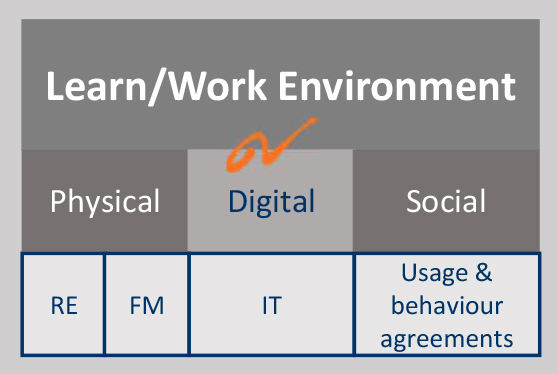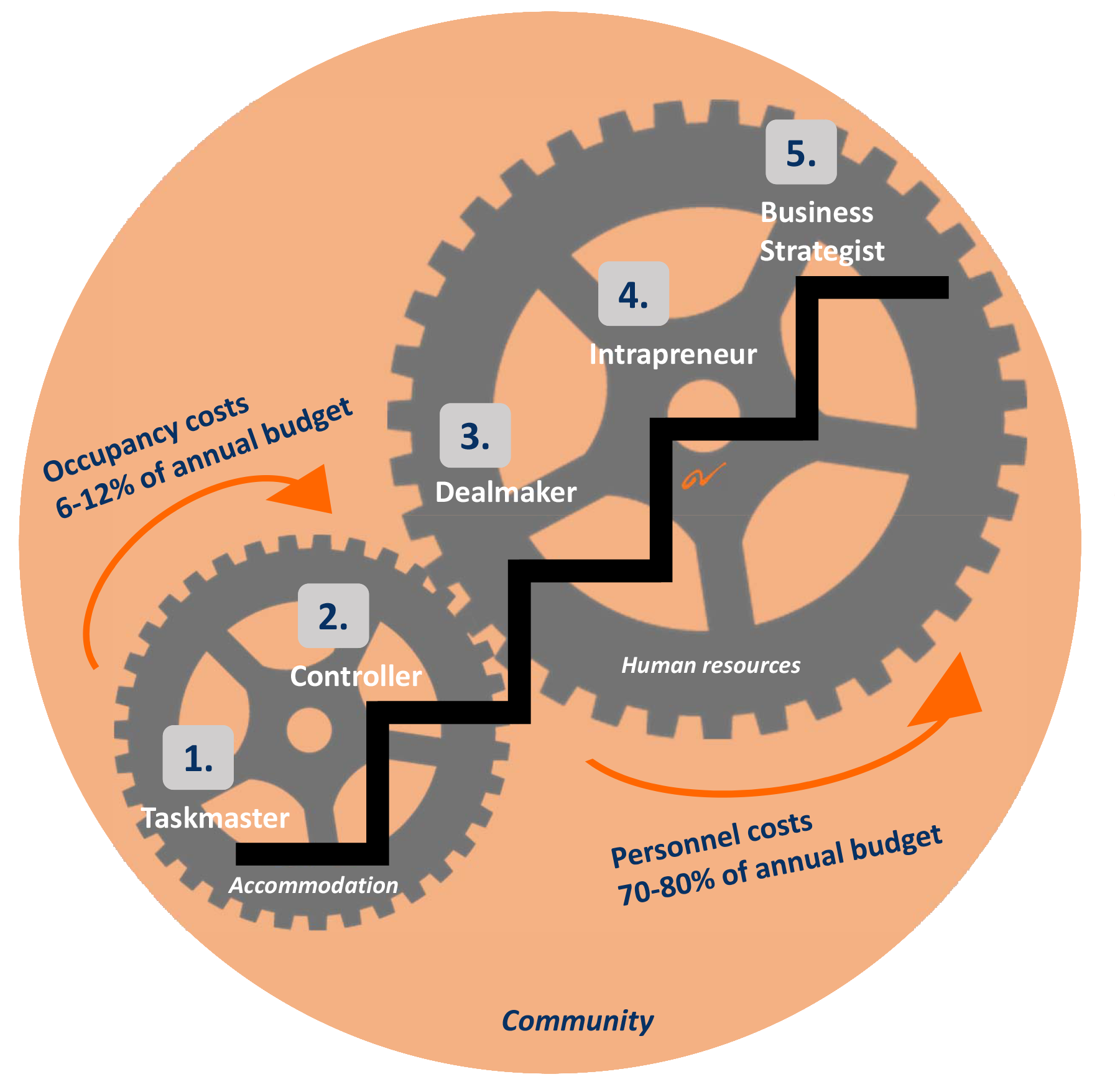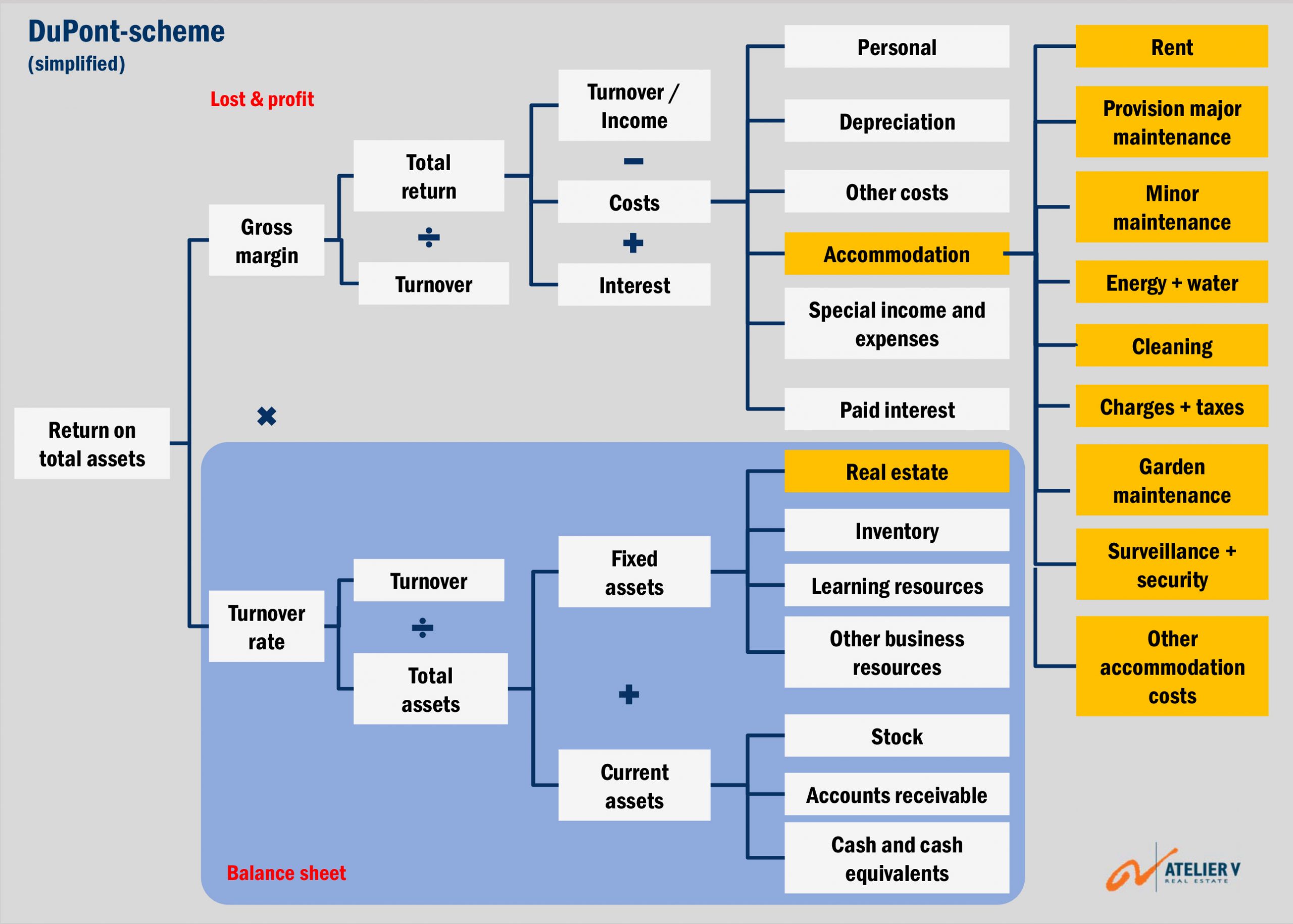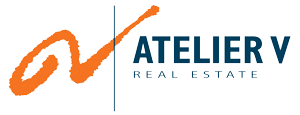Dynamics in organisations mean that they will periodically recalibrate the current learn/work environment. Because environments that are out of balance create demands, pressures and finally stress responses in people.

Space as managerial discipline
Shaping change is a continuous process and requires expertise and decisiveness.
Buildings become more efficient, effective and inspiring for the users by integrating a relevant mix of internal and external, hard and soft datasets (big data) in building management.
It creates the next step: the INTERNET of SPACES (IoS) or spatial alchemy, a new holistic way to interact with our built environment. Comparing multiple data reveals relationships that were previously hidden. It helps to make the accommodation process more efficient and effective. And perhaps even create more healthy soulful and therefore inspiring buildings.
Too often an intelligent building is reduced down to the choice of a building management system but there is much more to it than that. Buildings full of sensors that register anything and everything are far from smart. It is not about technology or software. Space as a managerial discipline is about understanding the complex interrelationship in the ecosystem of the learn/work environment (Bricks, Bytes & Behaviour). The connection between the users, the building and Information Technology (IT) to deliver improved effectiveness and improved user experience. This is more than creating so-called ‘smart’ buildings, which are usually more about the smart marketing of technology.
So-called Intelligent Buildings should move away from merely a focus on technology and building efficiency, to a focus on the needs of owners, organisations businesses, and most importantly their people. The key players should work in a holistic ecosystem to offer one common purpose: creating better experiences for people.
The success of an intervention in the learn/work environment is determined by behaviour. You can create the most beautiful interventions and arrangements, but if the people show old behaviour then you gain nothing. Changing the learn/work environment to influence behaviour (nudging) can be an effective way to support culture change and new structures.
“INTERNET of SPACES (IoS) or spatial alchemy, makes buildings and spaces more efficient, effective and inspiring. A new way to interact with our learn/work environment”. (René P.M. Stevens)
For organisations concerned with and profiting from knowledge, conversation, exchange of ideas and learning are fundamental parts of their production process. The accommodation has the potential to light an inspiring fire that makes a significant contribution to the organisational goals of the user of the accommodation and the well-being of the people working in the building.
However, just like with a match, friction/resistance has first to be bridged in order to unlock this potential. Accommodation management is basically spatial alchemy and needs intelligent design. But what if there is an organisational force that can be viewed as innate ‘intelligence’, without the need for an intelligent designer or devices? Organism and environment interact with each other. Biology is always adjusting to the environment around it. In a way, this exceeds the strictly materialistic view of the world.
Spatial alchemy
Spatial alchemy is about rethinking the type of environment we live and work in, the materials that our buildings are built from, the spaces that confine our daily lives, the technologies that we use, and even the people we interact with.
The shape and alignment of a building have a direct effect on physical, chemical and biological processes. Place and space can influence human health and well-being in various ways. People are energy systems.
According to Louis Turenne shapes such as pyramids, spheres and squares act as resonators for telluric and cosmic forces. Just as the shape of a violin improves the quality of tone, the shape provides a resonant cavity for crystalline structures, Such as materials and biological life including humans.

The geometry of a space influences the way atoms and air interact and move within a given area just as a vortex in water behaves differently according to the shape through which it flows.
Geometrical shapes do have a corresponding effect on the human body’s own geometry and energy. Thus rooms of different shapes generate different energetic environments that are capable of influencing the senses.
According to Freddy Silva in his book The Divine Blueprint, “In ancient temples, the geometry of nature was dissected to reveal the inner blueprints of forms and shapes; their cause and effect were measured and considered, and once it was established that form follows function, specific geometries were applied functionally and strategically to the design of temples so as to induce a corresponding effect on the individual’s state of awareness. If geometry shapes the universe then surely, the ancients posited, the living geometry of a temple can help reshape people.”
Freddy Silva continues: “Geometry and strategic angles were used in temples – inside, outside, overtly or invisible – to initiate a process of sensory manipulation that begins to open the body’s electrical circuits, making it more receptive to finer, more penetrating frequencies and vibrations.”
Geometry is a visual representation and structural manifestation of vibrations as sound is an audible manifestation of vibration. Architecture makes energy vibrations visible for all to see, use and enjoy. The structure of space is based on tetrahedral geometry and the toroidal dynamics of a sphere.
“Why does this space feel good?” is a similar question to “Why does this music move me to tears?”
(Richard Feather Anderson)
As Egyptian architect Dr Ibrahim Karim puts it: “the spatial arrangement, whether as musical intervals or geometrical configuration, is what achieves the synergy where the final qualities are much beyond what can be found in the components. This is the pattern that we perceive as the quality of the energy system as a whole.”
By tuning the subtle energy (Extremely Low Frequency/torsion field) of a building and of electromagnetic fields and radiation (EMF/R) emanating from both man-generated and natural sources, a musical symphony is created instead of a cacophony of sound. Architecture is a Symphony of Form. This creates a built environment where people and organisations can recharge themselves to create value together.
Proportions of classic buildings are mostly based on the harmonics of the Golden Ratio, the spiral that underlies all living organisms. Since the same proportions are inherent in the human body, walking into such buildings you feel as though you are an integral component of the structure, the ‘musical symphony‘.
The use of the sacred geometry Golden Ratio Phi (Ø – 1:1,618∞) and the Fibonacci sequence (nature’s universal rule that governs the dimensions of everything) makes a building more vibrant. Like resonance chambers of energy. A living environment that gives you energy as a person (and organisation) and that is also energy neutral in use. The building and its environment as a power plant.
Ultimately, every change comes from individuals who are willing to open their minds to new ideas. Someone who follows his or her intuition and has the courage and faith to think and act differently and the confidence to go for it.
The Real Estate/Facility manager as a goldsmith is someone who combines his vision with his skills and talents to transform the ordinary and everyday into something special with a higher added value. Someone who, instead of finding the things that are going wrong, looks for the hidden potential and the possibilities to transform this potential into tangible reality.
The learn/work environment is spatial alchemy and provides a managerial lever if approached. Space itself is a journey, not a product– the business of space and requires a whole ecosystem approach.
Inspiring living environment

Some interesting discoveries have been made in epigenetics (above genetics). Epigenetics is a new discipline within the field of biology that is concerned with unravelling the mysteries of how our environment affects the behaviour of cells without changing the genetic code. Because our human body consists of cells, human behaviour is also influenced by our (inner and outer) environment.
Since our built environment is an integral part of the outer environment, Winston Churchill’s quote “We shape our buildings; thereafter they shape us” gets a new and deeper meaning. Perception (awareness through the 5 senses) is the switch that controls your body and behaviour.
Or as epigenetic pioneer Bruce Lipton PhD says in his book The Biology of Belief: “It’s the environment, stupid!” More precise our interpretation of it.
According to Greg Braden resonance in its simplest form, is an exchange of energy between two things. It’s a two-way experience, allowing each “something” to come into balance with the other. Our experience of what we believe is all about resonance between us and the facts with which we’re being confronted.
A person’s belief system determines behaviour as well because we can control our perceptions and we can control our environment. New science states that the mind and the belief system, being the databank of conscious and unconscious information, interpret the signals of the five senses and give meaning to the stimuli from the outer environment and express a response. Beliefs and consciousness create the perceived subjective reality for that individual, the positive as well as the negative life experiences.
The perception of being satisfied with the performance of the learn/work environment depends upon our interaction with the outer environment and the people in it, as well as our physical and mental constitution. Our nervous system is explicitly tuned to the electromagnetic field in our outer environment, including other people.
Property management or Corporate Real Estate Management (CREM) is more than just optimizing the occupancy rate and the costs of buildings. Have you ever calculated how quickly a saving is completely cancelled out by only a small production loss caused by sub-optimization of the accommodation costs and how long this counter-productive effect of short-term cost reduction will lag behind?
Accommodation management is in fact an alchemical process to create inspiring and liveable environments by means of (big) data and focused attention that is effective and efficient in relation to the value that is created there. Not only in physical habitable environments but also in the way in which we as people interact, collaborate and give substance to a sustainable corporate culture. A built environment with a soul and character that invites high(er) quality ambitions.

Human Capital
Accommodation (the environment, the building including facility services, resources and work arrangements) has the potential to allow people to undergo a transformative experience. An intimate and collective place of engagement. Where people are becoming more vital and energetic. Where the organisation can excel by working more like a community in creating value. It increases future-proof and agility because people can react more quickly or anticipate changing circumstances. We call that spatial alchemy. You can compare it to that elusive but decisive moment in the alchemical process when one metal changes into another. See also Customer Journey through a building 1 and Customer Journey through a building 2.
The human capital is of greater value for an organisation than the capital invested in its accommodation. How to make the ‘inner environment’ at least equal strong and valuable as the outer environment? How to create spirited work environments and spiritually strong organisations and employees? How to facilitate corporate spiritualism, a way of expressing more humanity?
Multiple value creation
The core of an organisation is to create value as a partnership, within a given social context. But what value is feasible and for whom? Multiple value creation is about simultaneously working on a coherent set of social, ecological and economic values that, in addition to money, can consist of care, education, energy and other means of transaction. Profit thus becomes more than just money. Values that are not a by-product or the result of good intentions but that are consciously organized. Creating value from the Triple Bottom Line principle of People, Planet, Profit.
“It’s about the integration of the core organisational process,
and smart people facilitated by a smart building.” (René P.M. Stevens)
If the idea of the value proposition and for whom we create that value is clear, is there also suitable and inspiring accommodation in or with which it can be realized? How do people remain intrinsically driven to create not only profit but also value with heart and soul? An approach in which ecological and social returns have equal attention as economic returns.
From straitjacket to tracksuit

The built environment has a significant influence on the attitude and behaviour of people, the more soft Human Resources aspects. Environmental psychology is the discipline that studies the influence of the external environment on human behaviour. Accommodation is therefore a driver and facilitator for value creation.
What spices are to create a tasteful dish, are location and building for the value creation of an organisation. A relatively small amount of spices can make or break a dish. Accommodation costs represent on average “only” about 8-12% of the annual budget. Personnel costs represent on average approximately 70-80% of the annual budget. The learn/work environment is a lever that affects the health, well-being and productivity of the largest cost item in an organisation, the employees. See also Location and building, herbs for creating value.
“Make our built environment great places to live by supporting human health, well-being and performance.” (René P.M. Stevens)
In order to actually achieve the desired value creation with the learn/work environment, under the adage “measuring is knowing and guessing is missing”, it is essential to describe the building interventions clearly and measurably. This makes it possible to determine whether the quantitative and qualitative goals have been achieved and, if applicable, whether the desired behavioural change has occurred. In addition, insight is gained into the requirements that current legislation and regulations impose on the physical learn/work environment and the extent to which the buildings in use comply with these. Value creation involves much more than just the right price-performance ratio.
The evidence-based measurement results provide the responsible property/facility manager with input for communication to create momentum for change. Communication with those involved about the measured results and their satisfaction with the accommodation is crucial to bring about and secure the desired change. After all, it is about the optimal development of the potential of employees and users of livable (built) environments.
All this will lead to a quality impulse for the entire organisation that will (ultimately) translate into the quality of the primary process, and the (social) return within the established sustainability and the social responsibility policy to create shared value. Putting social value (People and Planet) first instead of profit maximization (Profit) is increasingly becoming the starting point for organisations that work with new business models.
Measuring accommodation performance
The Real Estate General Positioning Survey® (RE-GPS®) makes it possible to objectively describe the desired performance of the learn/work environment at the level of a location, building and work/learning/care place. Subsequently, a so-called supply profile is drawn up for each building of the actual available performance.
By comparing these two profiles, it is clear at a glance where the deviations between the desired and actual building situation lie. It forms a Strategic Accommodation Roadmap that enables navigation in a dynamic environment. On this basis, the quick wins can be identified and, if necessary, an intervention (course correction) can be decided. RE-GPS® has the measuring method REN (Real Estate Norm®) inside.

Benefits and costs of accommodation
A learn/work environment has both benefits and costs. Direct financial income from the accommodation is only available in the event of the sale of real estate, shared use and/or (sub) letting of space. It goes without saying that sales revenues are “only” incidental revenues. Just like your “table silver”, you can only monetize it once.
Indirect contributions of the learn/work environment to the value creation process of an organisation, such as an increase in the productivity of employees and in the learning performance of students, cannot be directly deduced from the annual accounts. Just as this is not the case with marketing expenditure. It is sometimes said that half of the marketing budget is wasted money, we just don’t know which half.
Using a DuPont analysis, what-if scenarios can be used to simulate the possible effects within the context of one’s own strategic organisational goals. In this way, the added value of the accommodation intervention(s) can be quantified in an integral value case. Value engineering instead of just cost reduction.
The strategic organisational goals are by definition unique to an organisation. The Strategic Alignment Matrix® helps to map out your own strategic goals and to make the link to the value drivers that the learn/work environment has an influence on. Subsequently, interventions in the accommodation are derived that must contribute to adding value to the organisational goals. The learn/work environment influences the four strategic management areas: Finance, Market & Communication, Personnel & Organisation and Primary process and thus (also) has an indirect effect on the business results of an organisation. The learn/work environment contributes to the economic goals: Finances – Primary process (What can the building do?), And to the social goals, Personnel & Organisation – Market & Communication (What does the building do to you as a person?).
Accommodation scenarios for value creation

It is tempting to pay particular attention to the easy-to-measure direct (accommodation) cost reductions. Reducing accommodation costs is like downsizing: often fine as a temporary measure, but it should never be a goal in itself. Slimming can go too far, only past the turning point it becomes visible that it has gone too far. A more efficient (read smaller) area use is often confused with an increase in employee productivity.
The learn/work environment has a direct effect on the well-being, engagement and motivation of students and employees and thus their learning and work performance. In most cases, employees form the largest cost item approx. 70-80%) of the total budget, it is they who ensure the intended (social) return.
In the vast majority of cases, indirect benefits and indirect cost reductions through the learn/work environment are more profitable than direct reductions in accommodation costs.
From business case to value case
By calculating the quick wins with the aid of accommodation scenarios, the optimal balance between the four management areas of value creation (Operations, Finance, Sales & Marketing and Human Resources) can be determined. The DuPont analysis can be used as a simulation model to explore the financial effects.
A quick scan often yields surprising results. Results that can sometimes improve the learn/work environment in an instant. By merely making accommodation more congruent with the business style or the educational concept. In this way, modifications to the accommodation, however small they may be, can positively help and/or support development and change in a team. You see the accommodation changes, you notice it, you feel it, you experience it, so concretely that people start moving. The learn/work environment as a strategic means to achieve the strategic goals.
An additional advantage of these adjustments or changes in or to the learn/work environment is that they communicate well to all stakeholders. And what about other positive effects. What effect would a pleasantly congruent accommodation have on the quality of life and learning/work performance? The absenteeism? Have you ever made that calculation? You will be surprised at the impact it has on the results. Not only on learning/work performance but also financially.

As an organisation, dare to think big, but start small and expand incrementally. Without experimentation, innovation is impossible. Experiment and gradually find out which form and speed of implementation suit the organisation best. Have faith in the process. Like anything new, it takes a bit of trial and error before you get it right, but the payoff is worth it.
If Real Estate as Spatial Alchemy resonates with your feelings, please feel free to contact us. We will make, without obligation, a tailor-made proposal for you, on how you can create (more) value with the learn/work environment.
